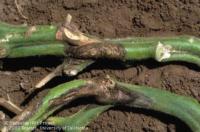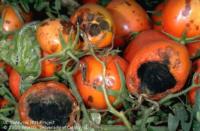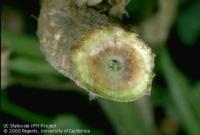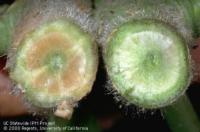Tomatoes, diseases
-
Tomatoes can be susceptible to various fungi and viruses. General measures that can be taken to help keep plants healthy include:
-Plant resistant varieties (see definitions below)
-Plant far enough apart for adequate air circulation
-Avoid overhead watering
-Keep soil evenly moist but not wet
-Use mulch
-Rotate location in the garden every 2-3 yearsResistance Definitions These abbreviations are found on the plant tags.
V = Verticillium Wilt (fungus) A = Early Blight (Alternaria fungus)
F = Fusarium Wilt (fungus) FF = Fusarium Wilt race 1 and 2
N = Nematodes (roundworms)
T = Tobacco Mosaic Virus TSW = Tomato Spotted Wilt (virus)Early Blight (Alternaria solani)
Dry, black or brown spots appear on leaves, stems, and fruit. The fungus likes cool, wet conditions, especially after a rain. Avoid overhead irrigation. Crop rotation is useful in infested gardens. Copper fungicides applied at the first sign of infestation and repeated every 7 to 10 days may provide control.Black Mold (Alternaria alternata)
Light to dark brown spots appear on the fruit and can become large sunken lesions. The fungus likes wet conditions and high humidity. Avoid overhead sprinklers late in the season and pick fruit as soon as it ripens.
Fusarium Wilt and Verticillium Wilt
Fusarium and Verticillium Wilts are hard to distinguish in the garden. Plants start to turn yellow and die beginning on one side and gradually spreading throughout the plant. The fungus infects the plant tissue and restricts water flow through the plant. The fungus survives in the soil even without tomato plants present. Plant resistant varieties. If wilts have been problematic, you can try soil solarization to reduce the fungus population in the soil.
Read more about tomato diseases.




